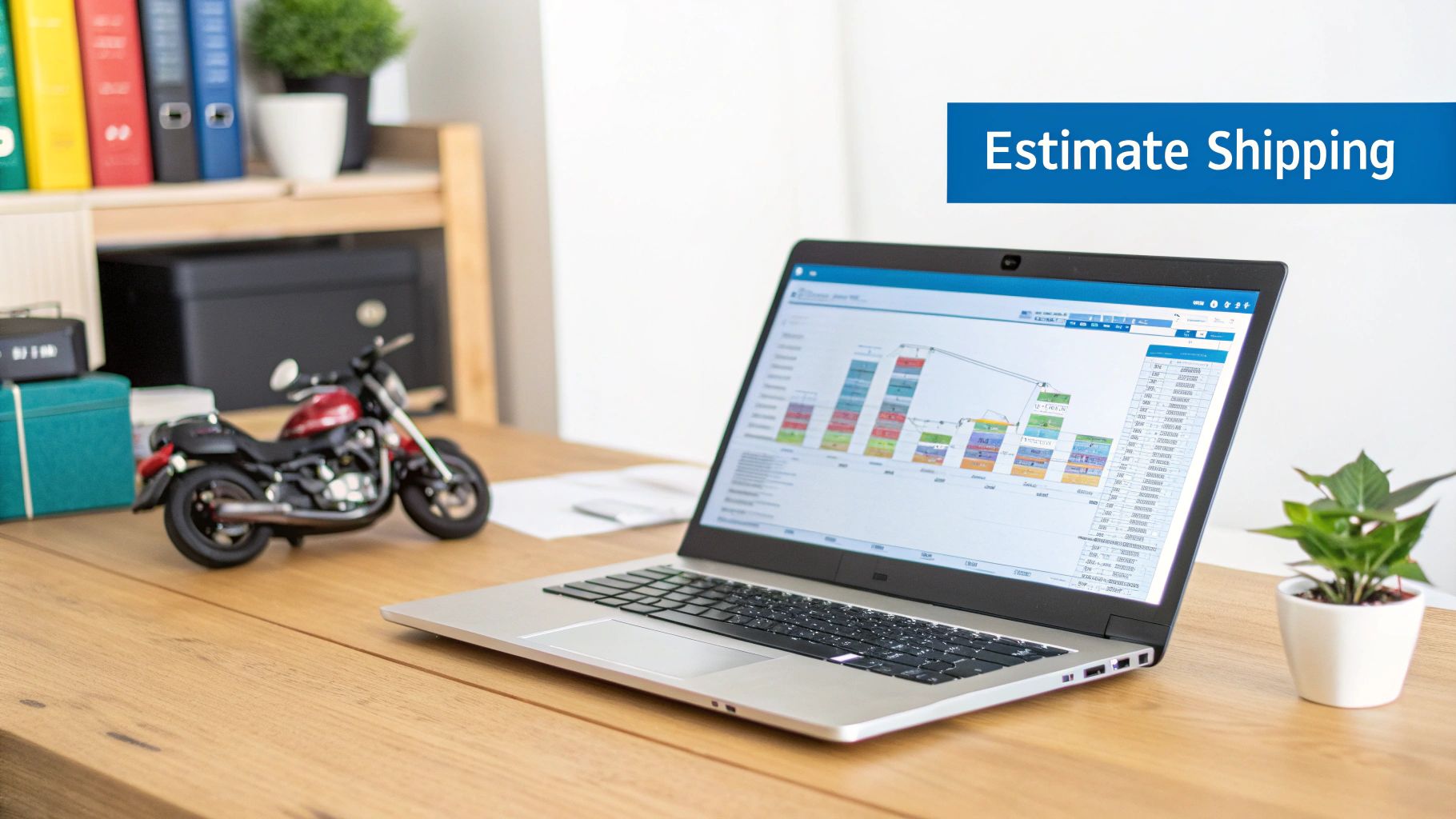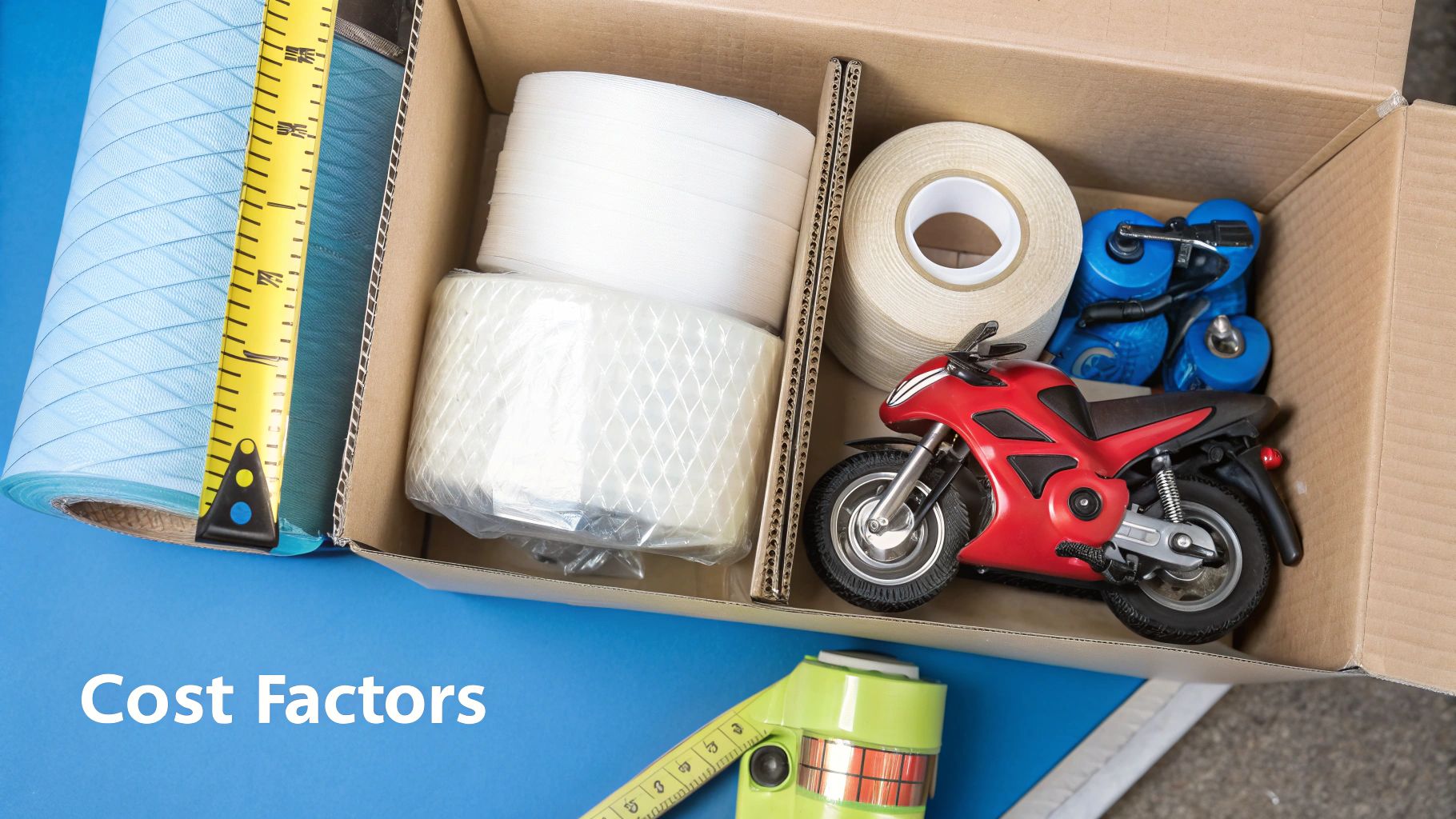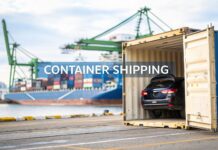
A motorcycle shipping cost calculator is your first step to getting a real-world price estimate. It’s an essential tool that takes the key details about your shipment—where it's going, what kind of bike you have, and how you want it shipped—and crunches the numbers based on current logistics data to give you an actionable quote.
How a Motorcycle Shipping Cost Calculator Really Works

When you input your details and click "Get Quote," you're engaging a sophisticated logistics tool, not just a simple form. A reliable motorcycle shipping cost calculator gives you a solid baseline price by instantly comparing the core variables of your request against a massive, constantly updated database of transport industry data.
Think of it as a digital dispatcher. The system analyzes your information and balances it against real-world factors that drive shipping prices up or down. Understanding this process is the first actionable step toward a smooth shipping experience, helping you avoid unexpected price hikes and budget accurately.
What the Calculator Needs From You
To generate a precise quote, the calculator needs the essential building blocks of your shipment. This information creates a unique profile for your specific transport job.
The primary inputs you'll need to provide are:
- Pickup and Delivery Locations: Providing specific ZIP codes is crucial. This determines the total mileage, which forms the foundation of the cost.
- Motorcycle Specs: The year, make, and model allow the system to estimate the bike's dimensions and weight. A heavy cruiser like a Harley-Davidson Electra Glide requires more space and weight allocation on a carrier than a lightweight Kawasaki Ninja, directly impacting the price.
- Transport Type: Your choice between open-air and enclosed transport is a major cost driver. Enclosed carriers offer maximum protection from weather and road debris, but this premium service comes at a higher cost.
This is the foundational data for your quote. Before diving into other variables, let's break down how these inputs influence the final number.
Quick Look at Key Quote Factors
| Factor | What It Means | Actionable Insight |
|---|---|---|
| Route Distance | The exact mileage between your pickup and delivery ZIP codes. | Longer distances mean higher costs. Major transport corridors (e.g., LA to NYC) are often cheaper per mile than remote routes. |
| Bike Size & Weight | Your motorcycle's dimensions and curb weight, including modifications. | Be precise. Measure your bike if it has custom parts (wider bars, saddlebags) to avoid surprise fees. |
| Transport Method | Your choice between a standard open carrier or a protected enclosed carrier. | Choose open for cost savings on standard bikes. Opt for enclosed for high-value, classic, or custom motorcycles. |
| Location Type | Whether your pickup/delivery is in a major city or a remote, rural area. | If possible, meet the driver in a more accessible urban area to potentially lower your cost. |
This table covers the information you control. But what happens behind the scenes?
Behind the Scenes of Your Instant Quote
Once you submit your details, the calculator does more than just basic math. It cross-references your request with dynamic, real-time logistics data. It's not a static formula.
The algorithm analyzes factors like carrier availability along your specific route, current fuel prices, and seasonal demand. For instance, shipping a bike from Miami to Los Angeles is a common, high-traffic route, making it more competitive than a less-traveled journey from rural Montana to Maine. This live analysis allows the calculator to generate a quote that is both immediate and highly relevant to your specific transport needs.
Expert Tip: The more you understand the logic behind the quote, the more accurate your input will be. Providing precise information from the start is the most effective way to secure a reliable final cost.
The Key Details That Determine Your Shipping Quote

The final number on your shipping quote is the result of several critical factors working together. While distance is a primary driver, a handful of other variables can significantly swing the cost. Mastering these elements is the key to using a cost calculator effectively and avoiding surprises when the final bill arrives.
The carrier's first consideration is the motorcycle itself. A stock sportbike, like a Yamaha R6, is a standard load—it's light and doesn't occupy much space. In contrast, a fully-dressed Honda Gold Wing with saddlebags and a top case is a different challenge. It requires a much larger footprint on the trailer. Since carriers price their service based on space and weight, larger, heavier, and modified bikes almost always cost more to ship.
Open Air vs. Enclosed Transport
Your next major decision is choosing the transport method. This is a crucial choice that balances cost against protection.
- Open-Air Transport: This is the most common and budget-friendly option. Your motorcycle is secured on an open trailer, similar to those used for new car deliveries. While exposed to the elements, it's a safe and reliable method for most standard bikes.
- Enclosed Transport: This is the premium, white-glove service. Your motorcycle travels inside a fully covered trailer, shielded from rain, sun, road debris, and potential theft. It's the recommended choice for custom builds, vintage classics, or any high-value machine where you want to eliminate risk.
As a general rule, expect enclosed transport to cost 30-50% more than an open-air carrier. For a cherished bike, that extra peace of mind is a valuable investment. Our complete guide on motorcycle shipping options provides an in-depth comparison to help you make an informed decision.
Route, Season, and Service Type
The logistics of the trip itself play a massive role in the final quote. A popular, high-traffic route between major cities (like Los Angeles to Dallas) is more efficient and therefore cheaper for a carrier than a custom trip to a remote town.
Timing is also critical. Shipping costs fluctuate with demand, much like airfare. Prices peak during the busy moving season in spring and summer and can also increase around major events like the Sturgis Motorcycle Rally. If your schedule is flexible, shipping in the off-season (late fall and winter) is a reliable strategy for saving money.
Finally, consider your desired level of convenience.
Door-to-Door vs. Terminal-to-Terminal Shipping
Door-to-door offers maximum convenience, with the carrier picking up and delivering the bike directly to your specified addresses. Terminal-to-terminal is the more economical alternative, requiring you to drop off and pick up your bike at the carrier's local hubs. This requires more effort but can significantly lower your cost.
The motorcycle transport industry is dynamic. Valued at around USD 87.55 billion in 2025, it's projected to reach USD 163.3 billion by 2035. This growth is driven by demand, but shippers also face rising operational costs, including a 29% increase in fuel expenses and a 24% jump in insurance charges, which directly impact your quote. You can see the full breakdown in this detailed industry report.
Each of these details—the bike's size, transport type, route, and timing—is a critical piece of the pricing puzzle that a quality shipping calculator must accurately assess.
Getting a Quote You Can Actually Trust
An online calculator is a powerful tool, but its accuracy depends entirely on the information you provide. The objective isn't just to get a number; it's to get a reliable quote that won’t suddenly change when it's time to ship.
Let's use a practical example: shipping a classic Harley-Davidson Softail from a residential address in Chicago (ZIP 60601) to a new home in San Diego (ZIP 92101). This is a long-haul shipment where every detail matters.
Nail Down Your Bike's Real-World Specs
First, the calculator will ask for the year, make, and model. This provides a baseline for size and weight. However, a common mistake is forgetting to account for customizations.
Aftermarket exhausts, wider handlebars, or spacious saddlebags all alter the bike's dimensions. If you don't declare them, the carrier may arrive expecting a stock motorcycle and be forced to re-quote you on the spot—and the new price will be higher.
To ensure accuracy, take these actionable steps:
- Use a Tape Measure: Get the precise measurements. Measure the total length (from the front of the front tire to the rear of the back tire), the overall height (from the ground to the highest point), and the width at the widest point (usually the handlebars or mirrors).
- List All Modifications: Utilize the "notes" or "modifications" section on the quote form. Be specific. Mention details like "extended front fork," "ape hangers," or "oversized touring pack."
This five-minute preparation ensures the carrier allocates the correct amount of space, which is the key to locking in your price and preventing day-of-shipment issues.
Choose Your Shipping Style and Service
Next, decide on the transport method. For our Chicago-to-San Diego journey, enclosed transport is the recommended choice. While it costs more than an open trailer, it provides complete protection from road debris and weather across that long distance.
Then, select your service type. Since the move is from one home to another, door-to-door service is the most convenient. However, be aware that this can be more expensive than dropping the bike at a carrier's terminal. Be honest about your locations. If you live on a narrow street where a large truck cannot maneuver, inform the shipping company. They can arrange a nearby, accessible meeting point.
Expert Tip: Think from the carrier's perspective. What information do they need to perform their job safely and efficiently? The more precise your details, the more accurate your quote. A reliable quote is built on transparent communication.
It's also useful to understand the market. According to recent U.S. shipment data, motorcycles make up only about 0.6% of all vehicle shipments. This lower volume means carriers have fewer economies of scale compared to cars, which makes an accurate initial quote even more critical.
By taking the time to enter these details accurately, you are setting the stage for a smooth, predictable shipping process. To see how these factors affect your own shipment, you can get a free shipping quote and apply this knowledge directly.
Navigating International Shipping and Border Fees
Shipping a motorcycle internationally is a far more complex process than a domestic move. This is a significant blind spot for many riders, as most online calculators are designed for domestic routes and cannot account for the intricate web of international fees. Without proper planning, these extra costs can escalate quickly and shatter your budget.
The primary expenses to anticipate are customs duties, import taxes, and tariffs. These are not minor handling fees; they are government-mandated charges based on your bike's declared value and the trade agreements between the two countries. These can add a substantial percentage to your final bill.
Understanding Cross-Border Costs
Your initial shipping quote should be viewed as the base transport cost—the price of moving your bike from point A to point B. The final invoice, however, will include additional charges that are applied once it reaches the port of entry.
Here is a practical breakdown of the typical fees involved:
- Customs Duties: A tax levied on goods crossing international borders.
- Import Taxes (GST, VAT, etc.): A sales tax on imported items, with rates that vary significantly by country.
- Port Fees: Charges for unloading, processing, and storing your motorcycle at the port.
- Brokerage Fees: The fee paid to a customs broker for managing the complex paperwork and ensuring customs compliance.
The variance in base shipping rates for domestic transport gives you an idea of the starting point before any international fees are added.
As shown, the difference between domestic carriers can already exceed $100. Now, imagine layering taxes and duties on top of that base price.
The Impact of Tariffs and Paperwork
Do not underestimate the impact of tariffs. Shifting trade policies can drastically affect costs. For example, a recent 25% tariff was applied to many motorcycles and parts imported into the U.S. Such a fee can add thousands of dollars to your cost overnight, making a reliable estimate more crucial than ever.
Paperwork is the single most critical element. It is your motorcycle's passport, and any error can halt its journey at the border. You will need the original title, a detailed bill of lading from your carrier, and proof of ownership. A single mistake or missing document can lead to costly delays, daily storage fees at the port, or even the outright rejection of your shipment.
To ship a motorcycle across borders, you must prepare a specific set of documents and adopt a meticulous mindset.
International vs. Domestic Shipping Checklist
| Requirement | Domestic Shipping | International Shipping |
|---|---|---|
| Proof of Ownership | Usually just a bill of lading is enough. | Original title is almost always required. |
| Photo ID | Required for pickup/delivery. | Required, and must match ownership docs. |
| Customs Declaration | Not applicable. | Mandatory. Details bike value, origin, etc. |
| Import/Export Permits | Not applicable. | May be required depending on the country. |
| Bill of Sale | Recommended. | Often required to prove value for tax purposes. |
| EPA/DOT Forms | Not applicable for domestic moves. | Required for U.S. imports to prove compliance. |
This checklist highlights the increased documentation required for international transport. The process demands meticulous attention to detail.
When shipping internationally, assume nothing. Your most important action is to verify the specific document requirements for both the departure and arrival countries well in advance. A reputable international shipper will guide you, but the ultimate responsibility for providing accurate paperwork rests with you.
Navigating this process requires specialized knowledge. To fully prepare, review a comprehensive guide on international motorcycle shipping to ensure your bike’s journey is seamless.
Insider Tips for Nudging That Shipping Quote Down
The initial number from a motorcycle shipping cost calculator should be seen as a starting point, not the final price. With strategic planning, there is almost always an opportunity to reduce that estimate. The key is to understand carrier flexibility and how you can align your needs with their operational efficiency.
One of the most effective strategies is timing. If you can avoid the peak moving season, you will almost always save money. Transport companies are busiest in the spring and summer. During the late fall and winter, demand decreases, and carriers are more motivated to fill their trucks. Shipping during this off-season can often save you 10-15%.
Be Smart About Your Service Level
Another significant cost-saving measure is choosing terminal-to-terminal shipping over door-to-door. While door-to-door service is convenient, that convenience comes at a premium. Maneuvering large trucks through residential areas costs carriers time and fuel—costs that are passed on to you.
By dropping your bike off at their local depot and picking it up from the destination terminal, you eliminate these "last mile" fees. This requires some logistical effort on your part but can lead to substantial savings, especially on long-distance shipments. For many, a couple of hours of effort is well worth saving over a hundred dollars.
A critical word of caution: if a quote seems significantly lower than all others, investigate it thoroughly. Unusually low prices can be a red flag for hidden fees, such as surprise fuel surcharges or residential delivery fees, that appear later. In worse cases, it could indicate a carrier that is cutting corners on insurance.
Master the Art of Comparing Apples to Apples
Getting multiple quotes is essential, but the real skill lies in how you compare them. Look beyond the bottom-line number and analyze the details of what each quote includes.
Create a simple checklist or spreadsheet to compare offers side-by-side:
- Insurance: What is the declared value limit? Is there a deductible?
- Service Type: Is the price for door-to-door or terminal-to-terminal service?
- Transport Method: Does the quote specify an open-air trailer or the more protective enclosed option?
- The "All-In" Price: Does the quote explicitly state that it includes all taxes, fuel surcharges, and other fees?
This methodical comparison provides a clear picture of the true value of each offer. It empowers you to avoid lowball quotes that end up costing more and helps you select a reliable carrier that meets your needs and budget.
Common Questions About Motorcycle Shipping Costs
Even with a detailed quote from a motorcycle shipping cost calculator, questions are bound to arise. Here are actionable answers to some of the most common inquiries to help you book your shipment with confidence.
How Accurate Are Online Calculators, Really?
A reputable online calculator is highly accurate, typically falling within 10-15% of the final price, provided the information you enter is precise.
Consider the instant quote a reliable estimate, not a legally binding contract. The final, official quote is issued after the transport company verifies all variables, including current fuel costs, specific carrier availability, and route logistics. Your accuracy in the initial stage directly impacts the accuracy of this estimate.
What’s the Deal with Insurance and Packing Extra Gear?
A common question is whether the quoted price includes full insurance. The answer is typically no. Standard quotes include basic liability coverage as required by law, but the coverage limit may be less than your motorcycle's actual value, especially for custom, vintage, or high-end bikes.
Your key action is to ask the carrier for the specific coverage amount and a list of exclusions. For complete peace of mind, inquire about purchasing supplemental insurance to cover the full value of your motorcycle. Always get the full policy details in writing before signing the contract.
Another frequent query is about packing personal items with the bike. DOT regulations strictly prohibit the transport of personal belongings inside a vehicle being shipped. This is a safety and liability rule that can result in fines for the carrier and may void their insurance. The most practical solution is to ship your gear separately via a parcel service.
What's the Absolute Cheapest Way to Ship a Bike?
If minimizing cost is your primary goal, you can achieve the lowest possible price by combining several strategic choices.
Your most budget-friendly transport plan will almost always involve these three elements:
- Terminal-to-Terminal Service: You handle the drop-off and pickup at the carrier's depots, eliminating the extra cost of residential service.
- Open-Air Carrier: Shipping on an open trailer is significantly cheaper than enclosed transport and is a safe option for the vast majority of motorcycles.
- Off-Season Timing: If your schedule is flexible, shipping during the late fall or winter, when demand is lowest, will yield better pricing.
This approach requires more personal involvement but delivers the most significant savings. You are effectively trading convenience for a lower price—a trade-off many riders are willing to make.
Ready to get a clear, accurate price for your shipment? The experts at We Will Transport It are here to help. Use our advanced motorcycle shipping cost calculator to get a transparent quote in minutes. Plan your motorcycle's journey with confidence today!





